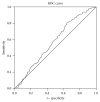Thyroid Hormones, Autoantibodies, Ultrasonography, and Clinical Parameters for Predicting Thyroid Cancer
- PMID: 27313612
- PMCID: PMC4893455
- DOI: 10.1155/2016/8215834
Thyroid Hormones, Autoantibodies, Ultrasonography, and Clinical Parameters for Predicting Thyroid Cancer
Abstract
Our objective was to evaluate thyroid nodule malignancy prediction using thyroid function tests, autoantibodies, ultrasonographic imaging, and clinical data. We conducted a retrospective cohort study in 1400 patients with nodular thyroid disease (NTD). The thyroid stimulating hormone (TSH) concentration was significantly higher in patients with differentiated thyroid cancer (DTC) versus benign thyroid nodular disease (BTND) (p = 0.004). The receiver operating characteristic curve of TSH showed an AUC of 0.58 (95% CI 0.53-0.62, p = 0.001), sensitivity of 74%, and specificity of 57% at a cut-off of 1.59 mIU/L. There was an incremental increase in TSH concentration along with the increasing tumor size (p < 0.001). Thyroglobulin antibody (TgAb) concentration was associated with an increased risk of malignancy (p = 0.029), but this association was lost when the effect of TSH was taken into account (p = 0.11). Thyroid ultrasonographic characteristics, including fewer than three nodules, hypoechoic appearance, solid component, poorly defined margin, intranodular or peripheral-intranodular flow, and punctate calcification, can be used to predict the risk of thyroid cancer. In conclusion, our study suggests that preoperative serum TSH concentration, age, and ultrasonographic features can be used to predict the risk of malignancy in patients with NTD.
Figures




References
LinkOut - more resources
Full Text Sources
Other Literature Sources
